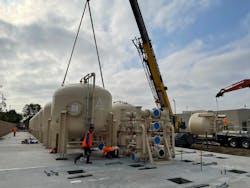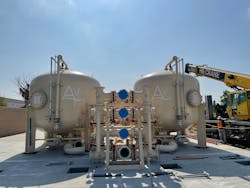In December 2021, the Orange County Water District (OCWD) and the Yorba Linda Water District (YLWD) in California began operation of the nation’s largest ion exchange treatment plant to remove per-and polyfluoroalkyl substances (PFAS) from local well water.
The Orange County Water District is a special district that manages the groundwater basin beneath central and northern Orange County, California. The groundwater basin provides a water supply to 19 municipal water agencies and special districts.
Yorba Linda Water District is a public agency serving residents of Yorba Linda and portions of Placentia, Brea, Anaheim and areas of unincorporated Orange. The district’s headquarters are in Placentia.
Focus on PFAS
In response to the state of California establishing lowered advisory response levels (RL) for two PFAS chemicals – perfluorooctanoic acid (PFOA) and perfluorooctane sulfonate (PFOS) – YLWD decided to temporarily shut down all of its active groundwater wells.
PFAS are being detected in water sources throughout the U.S., including the Orange County Groundwater Basin, which supplies 77% of the water supply to 2.5 million people in north and central Orange County.
Despite playing no role in releasing PFAS into the environment, water providers must find ways to remove it from their local water supplies.
YLWD – one of 19 water providers that pump water from the groundwater basin – had all of its groundwater wells impacted by PFOA and PFOS. These wells were among dozens of wells throughout Orange County that were removed from service in 2020 after the state of California lowered the Response Level advisories of PFOA and PFOS – two legacy PFAS compounds no longer produced in the United States.
The transition to purchasing 100% treated imported surface water sourced from the Colorado River and Northern California almost doubled YLWD’s water costs. A quick and cost-effective solution was needed.
Evaluating PFAS Treatment Options
Many options had been considered by those at YLWD for treating the groundwater wells impacted by PFAS. Different treatment methods, including reverse osmosis (RO), granular activated carbon (GAC) and ion exchange (IX) – were evaluated.
The most common method of an ion exchange treatment is a small set of vessels at affected wells. YLWD was more impacted than most, with all 10 active wells needing treatment.
Working collaboratively with its design and construction partners, OCWD and YLWD swiftly began construction of the PFAS treatment plant at the YLWD headquarters in March 2021. The plant became operational within the year.
OCWD selected AqueoUS Vets (AV) to build and supply 27 advanced LowPro ion exchange resin systems. Eleven of these systems were allocated to Yorba Linda Water District. Working with OCWD, Yorba Linda Water District, and Tetra Tech, AV provided design assistance, manufactured, and delivered the country’s largest ion exchange treatment PFAS removal treatment plant.
The treatment process removes impurities such as PFAS from the water before entering the distribution system. The PFAS treatment plant can treat up to 25 million gallons per day. It uses an IX resin treatment system made of highly porous resin that acts like powerful magnets adsorbing and holding onto contaminants.
The plant consists of six pre-filters, a booster pump station, a 1000-kilowatt backup generator, and of 22 IX vessels used in lead-lag configuration as eleven trains (or systems).
The influent and effluent supply pipelines can be operated to switch which vessel is the lead and lag position by controlling valves. The lead-lag arrangement is considered beneficial because once the PFAS constituents reach a predetermined threshold of the lead vessel’s effluent, then the lead vessel can be switched to the lag.
Flow Process
YLWD has nine wells that pump to the PFAS treatment plant varying in flow production. The operation of the wells is determined by customer demand. Prior to the water entering the IX vessels, it first passes through a pre-filtration system which uses 5-µ bag-filters to catch solids that may be discharged by the well.
During periods of high-water demand, all 11 systems are in use simultaneously and the water is distributed to each train — first going through the lead vessels and then to the lag vessels.
The water spends approximately two minutes in each vessel and the PFAS are treated to a non-detect level, then disinfected prior to being conveyed to YLWD’s Highland Reservoir and ultimately distributed to customers.
In terms of future projects needed going forward, the YLWD facility is among 36 PFAS treatment facilities being designed and constructed in Orange County over the next two years. OCWD is funding 100% of design and construction costs and 50% of operation and maintenance costs for its water suppliers like YLWD.
“Bringing this treatment facility online is very important for our customers,” said J. Wayne Miller, YLWD president. “In addition to being recognized as a great engineering feat, this facility reflects our commitment to provide a safe, reliable, and cost-effective water supply to our customers.”
“OCWD is committed to proactively and swiftly addressing PFAS in the Orange County Groundwater Basin,” said Steve Sheldon, OCWD president. “We are very proud of our collaboration with YLWD to rapidly construct this treatment facility to remove PFAS from groundwater and ensure that they continue to meet all state and federal drinking water standards.”
Location: Yorba Linda, California
Size: 25 mgd
Equipment: prefiltration, booster pump station, back-up generator, ion exchange
About the Author
Carol Brzozowski
Carol Brzozowski is a freelance writer for Wastewater Digest. Brzozowski can be reached at [email protected].


